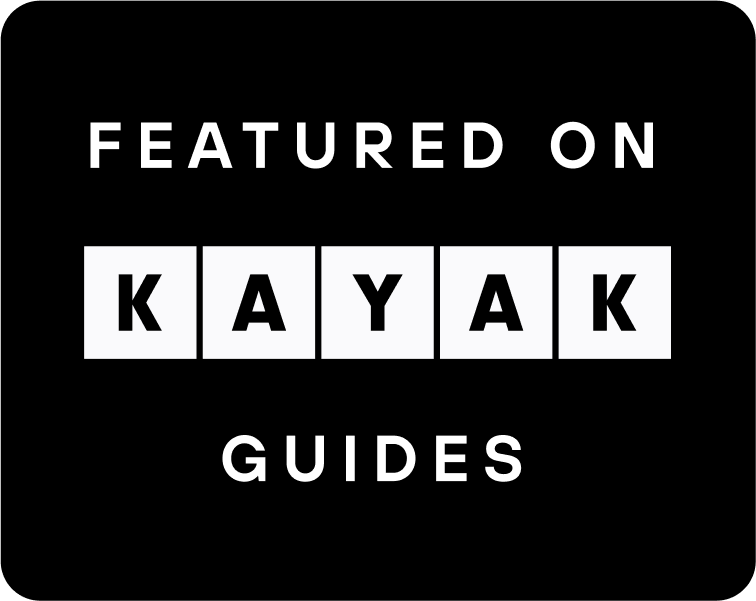JEREMY MIRANDA | Fool's Spring
Opening, 5pm - 7pm Friday, May 30 - June 21, 2025
Jeremy Miranda invites viewers into the quiet, introspective world of winter—its fleeting light, its hush, its deceptive thaws. Through 33 semi-abstract paintings, he captures the seasonal paradox of stillness and transformation, where the warmth of an early spring day is but an illusion, and the weight of winter lingers. His smaller canvases, like snapshots of daily life, depict intimate interiors, scattered objects, and shifting landscapes, evoking a cinematic sense of passing time. Meanwhile, his large-scale works immerse viewers in the vastness of a season both isolating and deeply reflective. Rooted in personal experience and an evolving artistic journey, Miranda’s work transforms the familiar—snow-covered fields, everyday messes, the glow of a late afternoon—into meditative studies on presence and perception. Fool’s Spring is not just about winter; it is about the ways we navigate time, memory, and the quiet beauty hidden in the spaces between.
View work in the exhibition ►
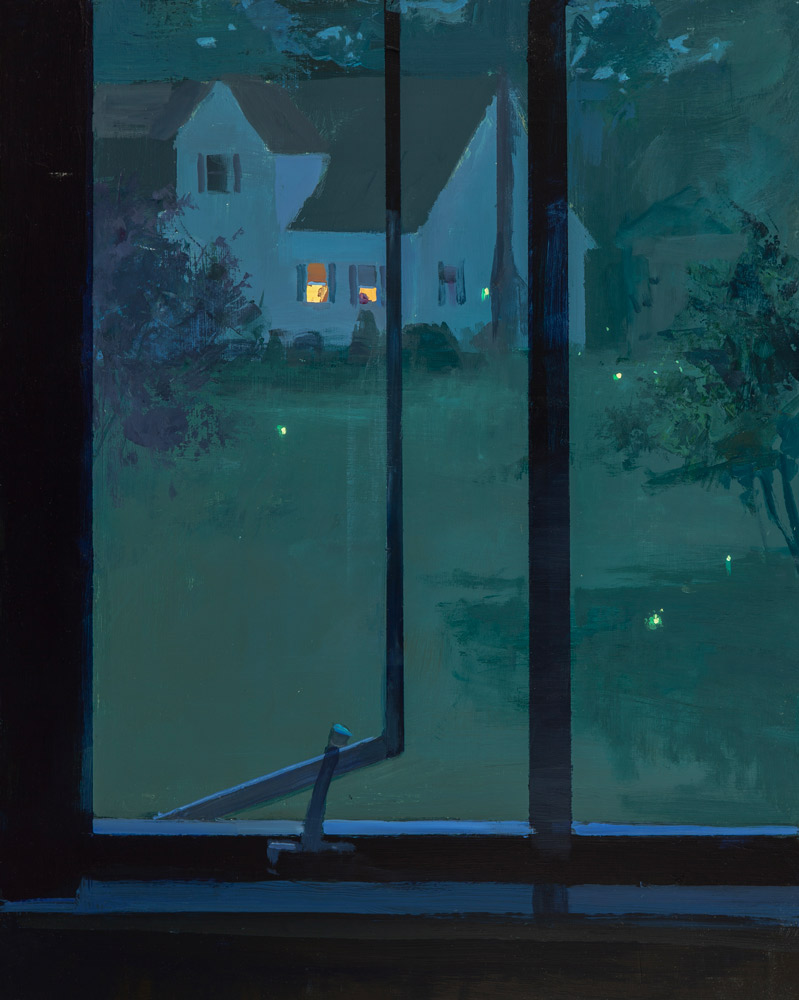
EVOKATION | art + culture + inspiration | April 2025 issue
Art is more than a form of expression; it is a fundamental part of human existence that enriches our lives in immeasurable ways. It shapes cultures, sparks imagination, and offers solace during difficult times. As a sanctuary from reality, art allows individuals to explore beauty, creativity, and emotion. Whether through painting, music, literature, or dance, it provides a medium for self-expression, healing, and reflection. Engaging with art stimulates the mind, nurtures emotional well-being, and deepens our understanding of the world around us.
Beyond personal enrichment, art fosters a sense of connection and community. It brings people together through shared experiences—bridging gaps between cultures, generations, and backgrounds. The universality of art reminds us of our shared humanity, fostering empathy, dialogue, and understanding. Even in the face of adversity, art continues to be a source of strength and transformation, proving its timeless and unifying power.
We are embracing this vision with a dynamic lineup of exhibitions and events for 2025. Our summer salon has become an intrinsic part of this mission, serving as a platform for conversation, inspiration, and the convergence of critical and creative thought. This year, we will expand our programming with more public talks featuring artists, curators, and visionary minds, alongside artistic demonstrations and multidisciplinary events spanning performance, literature, and the visual arts.
Join us at Evoke Contemporary for a year of vibrant creativity, thought-provoking dialogue, and immersive artistic experiences!
read past issues ►
Gallery Info
Founded in Santa Fe, NM in 2009, EVOKE Contemporary remains committed to providing a dynamic platform for exploring bold and thought-provoking contemporary art. The gallery is dedicated to fostering the careers of artists who embody authenticity, mastery, and vision, while nurturing works of profound depth and context. EVOKE Contemporary champions a diverse array of voices and artistic disciplines, representing artists whose work delves into the human condition, explores complex social values, and celebrates the beauty of nature and the human form.
EVOKE Contemporary is centrally located in the Railyard Arts District of Santa Fe along with the New Mexico Museum of Art Vladem Contemporary, and SITE Santa Fe, a contemporary art space, and seven additional contemporary art galleries. The Railyard district, a short walk from the historic Plaza, offers a Farmers Market, the Railyard Park, and an array of shopping, dining and, entertainment opportunities.
Gallery hours are: Tuesday through Saturday, 10 - 5.
You may reach us via Email and 505.995.9902 telephone messaging daily 10 - 5.
Thank you for your continued support.

LOOKING & SEEING
contemplations on a theme
Today's theme is Time
John O'Hern is an arts writer, curator and retired museum director who has been providing a biweekly contemplation of a single work of art from our gallery. He is continuing his series of contemplations of various themes inspired by our gallery artists. In our fast-paced lives overflowing with information, we find it necessary and satisfying to slow down and take time to look. We hope you enjoy this perspective from John.
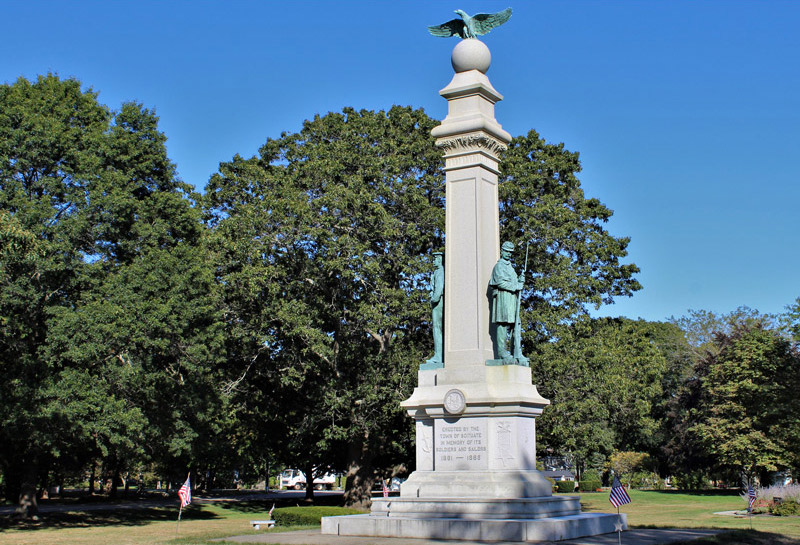 As Memorial Day approaches, I’ve been thinking about the observance of the day in the past—reciting the Gettysburg Address in front of the impressive Civil War Soldiers’ and Sailors’ Monument on the Lawson Common and playing in the Satuit Band in the Memorial Day Parade. (“Satuit” is the Wampanoag word for “Cold Brook” which runs behind what was my family home which, in an earlier time, was known as “Brookside Inn”. In 1640, Satuit was Anglicized to Scituate—for some, the unpronounceable name of a town on the South Shore of Boston.)
As Memorial Day approaches, I’ve been thinking about the observance of the day in the past—reciting the Gettysburg Address in front of the impressive Civil War Soldiers’ and Sailors’ Monument on the Lawson Common and playing in the Satuit Band in the Memorial Day Parade. (“Satuit” is the Wampanoag word for “Cold Brook” which runs behind what was my family home which, in an earlier time, was known as “Brookside Inn”. In 1640, Satuit was Anglicized to Scituate—for some, the unpronounceable name of a town on the South Shore of Boston.)
Memorial Day was the beginning of the summer tourist season which ended on Labor Day. My mother remembered that as a girl she had to wear her winter woolen underwear until that day no matter what and, I remember being warned not to go into the ocean any earlier than that.
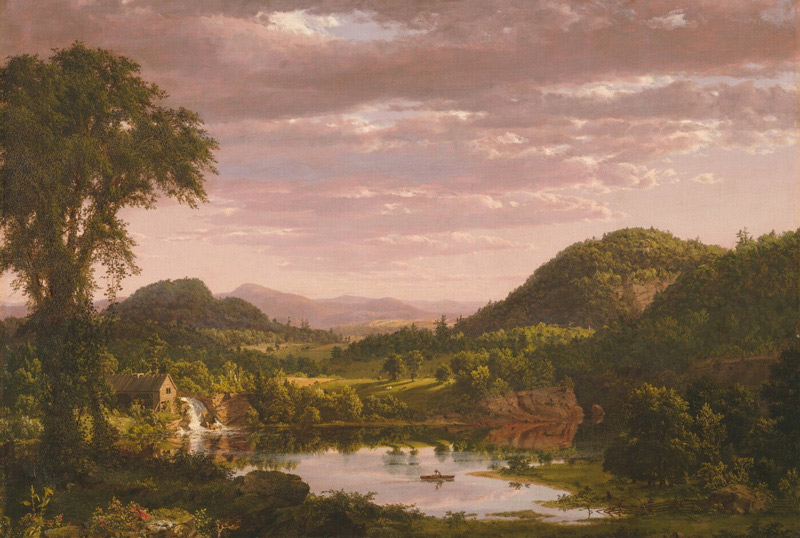 All that remembering got me to the theme of “Time”. There’s a great quote about time attributed to Albert Einstein, Richard Feynman, Woody Allen and others: “Time is what keeps everything from happening at once.” Van Gogh wrote, “It is looking at things for a long time that ripens you and gives you a deeper meaning.” A good segue into this week’s theme for Looking and Seeing.
All that remembering got me to the theme of “Time”. There’s a great quote about time attributed to Albert Einstein, Richard Feynman, Woody Allen and others: “Time is what keeps everything from happening at once.” Van Gogh wrote, “It is looking at things for a long time that ripens you and gives you a deeper meaning.” A good segue into this week’s theme for Looking and Seeing.
In New England, the mountains, for the most part, have been softened by erosion and second growth trees after having been heavily forested beginning in the 17th century. (The lumber for Brookside Inn arrived in Scituate Harbor on a wooden schooner from Maine.)
The landscape of the Southwest is different. Its history is revealed in exposed rock.
 David T. Alexander’s Multicoloured Erosional Mountains is an impression of the geological formation of the mountains and their continuing erosion, their clear strata of formation eroding together in wind and rain, blurring their history over time. His paintings embody the erosive geologic process as he builds up paint with brushes and trowels.
David T. Alexander’s Multicoloured Erosional Mountains is an impression of the geological formation of the mountains and their continuing erosion, their clear strata of formation eroding together in wind and rain, blurring their history over time. His paintings embody the erosive geologic process as he builds up paint with brushes and trowels.
In her essay on David’s work in the 2024 edition of Evokation, Staci Golar quotes his impressions of the processes of nature. ‘When it rains in the desert, the top layer of pigment in the soil gets washed down and runs over the other colors by gravity, like a brush veil of color from the top distributes the color to the bottom . . .That’s a thrill . . . and it’s not just the way it looks, but the way it feels in my experience . . . Things such as the crust of a hot land’s pigment are like colors of chiles, maize in unique shapes created by erosion. These things are what helped me create images of a land in flux.”
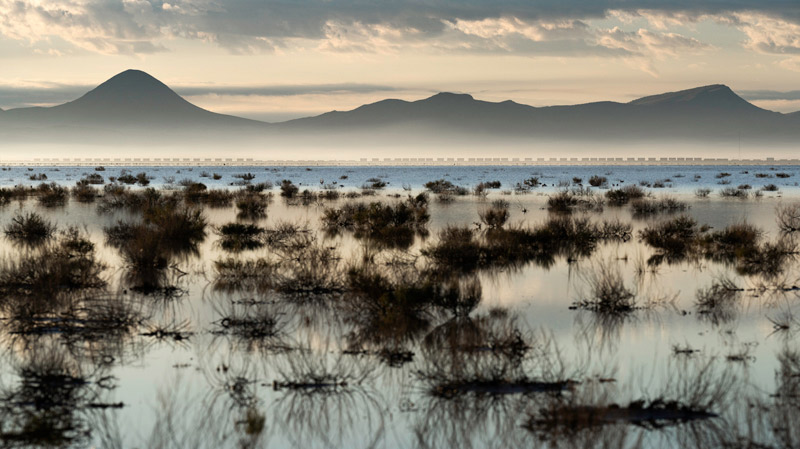 Esha Chiocchio’s drone photographs of the parched Lordsburg Playa in southern New Mexico, depict a land in flux and the intense effort to rejuvenate it. She writes, “In the late 1880s, when Euro-American settlers founded Lordsburg along the Southern Pacific Railroad line in the southwest corner of New Mexico, a sea of grass tickled their horses' bellies and provided ample feed for their growing herds of livestock. Yet, within a century, cattle had eaten the grass to the ground, and dust storms frequently enveloped Interstate 10, causing over forty fatalities along a twenty-mile stretch of highway since 1965.” She has been documenting the revitalization of the Playa for several years.
Esha Chiocchio’s drone photographs of the parched Lordsburg Playa in southern New Mexico, depict a land in flux and the intense effort to rejuvenate it. She writes, “In the late 1880s, when Euro-American settlers founded Lordsburg along the Southern Pacific Railroad line in the southwest corner of New Mexico, a sea of grass tickled their horses' bellies and provided ample feed for their growing herds of livestock. Yet, within a century, cattle had eaten the grass to the ground, and dust storms frequently enveloped Interstate 10, causing over forty fatalities along a twenty-mile stretch of highway since 1965.” She has been documenting the revitalization of the Playa for several years.
In an earlier edition of Looking and Seeing I commented on her photograph, Morning Train. The distant train, to me, appeared like a zipper across the 40-inch-wide image. Unzip the lower part of the photo of the Playa and substitute the arid desert, and you have images of a time of drought and a time of replenishment. Esha commented, “The train image needs to be large to be read properly. I got up early and went out to see what was going on. There was fog that morning and a train was passing in the distance. It was trains that opened up the land for ranchers and allowed them to get their cattle out to market. Heavy grazing consequently caused the grasslands to virtually disappear.”
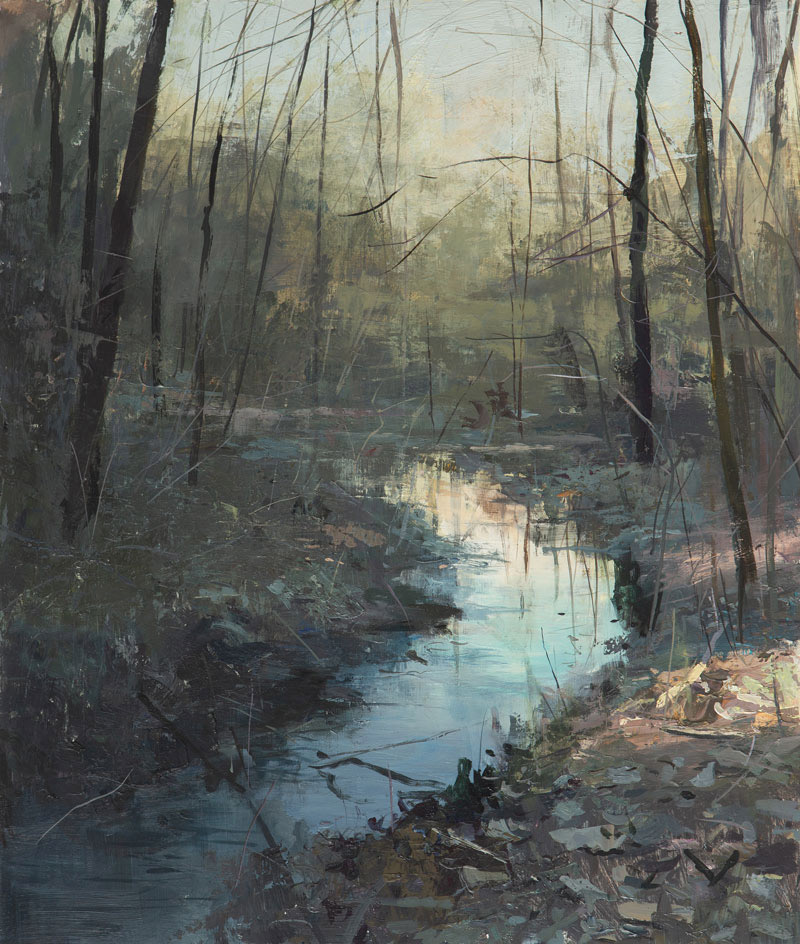 Jeremy Miranda’s painting Middle of March depicts a lengthy moment in what we called, when I lived in Maine, mud season. Another description of Maine weather is that there are two season, winter and the fourth of July. In experience, Maine seasons are varied and beautiful. In Middle of March, mountain snows and frozen ground are melting and streams are coming back to life, the browns just beginning to give way to myriad greens.
Jeremy Miranda’s painting Middle of March depicts a lengthy moment in what we called, when I lived in Maine, mud season. Another description of Maine weather is that there are two season, winter and the fourth of July. In experience, Maine seasons are varied and beautiful. In Middle of March, mountain snows and frozen ground are melting and streams are coming back to life, the browns just beginning to give way to myriad greens.
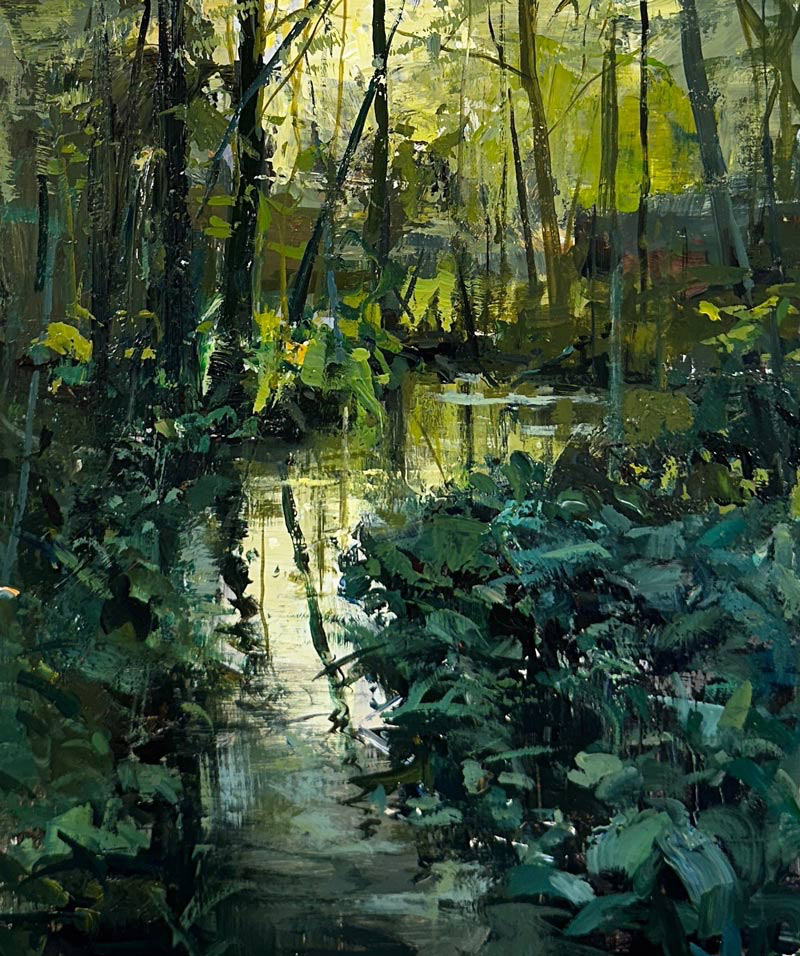 In a recent painting Creek Light, lush with greens, Jeremy noted, “The creek really woke up this week!” His paintings are alive with the subtleties of light from that of a gas flame on his kitchen stove to sunlight on a houseplant, to the shimmering reflections on a forest creek.
In a recent painting Creek Light, lush with greens, Jeremy noted, “The creek really woke up this week!” His paintings are alive with the subtleties of light from that of a gas flame on his kitchen stove to sunlight on a houseplant, to the shimmering reflections on a forest creek.
 Rowan Oak was William Faulkner’s home in Oxford, MS, for 32 years. He and his wife restored the decaying antebellum Greek Revival home. Also on the property is a barn which was built in the 1840s probably as the home of the original owners while the larger home was being built. The property is owned by the University of Mississippi, where Brian Rego is a visiting faculty member this year. Faulkner’s Cabin is one of several observations of the property he has done over the years.
Rowan Oak was William Faulkner’s home in Oxford, MS, for 32 years. He and his wife restored the decaying antebellum Greek Revival home. Also on the property is a barn which was built in the 1840s probably as the home of the original owners while the larger home was being built. The property is owned by the University of Mississippi, where Brian Rego is a visiting faculty member this year. Faulkner’s Cabin is one of several observations of the property he has done over the years.
In 2014, I interviewed Brian when he had co-founded a painting collective known as Perceptual Painters that emphasized painting, community and education. The painters rely on direct observation, painting their response to what is in front of them. He commented, then, on the energy that comes “from working directly from the motif.”
In an early edition of Looking and Seeing, Brian spoke about nature. “On a physical level, we come from it, and we return to it. There’s beauty and unpredictability, order and disorder, deconstruction and reconstruction. There’s the intelligence of nature. There are visual phenomena and those that can be described by physics, and there is the metaphysical. I sense all that happening at once. It’s profound, both present and timeless. It’s the miracle of existing, the fact that it even exists and even seems to exist beyond itself.”
 Aron Wiesenfeld’s subjects exist in a physical and metaphysical world, possessed of an inner strength or awareness that allows them to navigate an often hostile landscape on a journey they may not understand the purpose of until they reach its end. His paintings also attract us to accompany them on their journeys or on our own.
Aron Wiesenfeld’s subjects exist in a physical and metaphysical world, possessed of an inner strength or awareness that allows them to navigate an often hostile landscape on a journey they may not understand the purpose of until they reach its end. His paintings also attract us to accompany them on their journeys or on our own.
The Handmaid appears to beckon us to follow her into a tunnel. Tunnels and openings appear often in his work, “A loaded symbol” he says, a journey “between one reality and another”. Her mysterious presence is irresistible. We will join her, not knowing the purpose of the journey or the destination but, perhaps, feel the journey will take us to a more expansive, fulfilling realm—a different time. When we first spoke over 9 years ago, Aron commented on the mysterious paintings of Edward Hopper. “Most people see his paintings as materialistic with a beautiful light. I look at Hopper and see the metaphysical.”
Time is, as Brian Rego says, all “happening at once”—a mind-boggling concept that has occupied philosophers and scientists for hundreds of years. Emily Dickinson, who wrote her thoughts on scraps of paper and stashed them in the draw of her writing table, summed it up deceptively simply. In her poem “Forever”, she wrote, “Forever—is composed of nows."




